
Royal Worcester Blush Ivory Potpourri Jar, 1898, Floral Decorations
A Royal Worcester blush ivory potpourri jar and cover, Royal Worcester, shape 1312, date code for 1898., the potpourri moulded jar of lobed melon form with gilt pendant borders, decorated with colourful sprays of meadow flowers picked out in gold, all…

Royal Worcester Gilt Porcelain Potpourri with Fruit Still Life
A Royal Worcester gilt porcelain footed potpourri featuring pierced lid and fruit still life, signed Aynton, height 11 cm, signed.

Royal Worcester Harry Davis Pot Pourri Vase, circa 1902
A Royal Worcester porcelain pot pourri vase decorated by Harry Davis, shape 1515, circa 1902 (date cypher worn), the domed cover with finial above the globular body with a pair of foliate handles to the shoulders and raised on a low foot ring, the cover,…

Royal Worcester Pot Pourri with Highland Cattle by J. Stinton
A Royal Worcester lidded pot pourri, painted with Highland cattle, signed J. Stinton, two gilded handles, pierced with decorative gilding to the shoulders, lid and base. Date marks for 1924.16 x 20 cm.

Royal Worcester Highland Cattle Potpourri Vase, J. Stinton, 36.5cm
Royal Worcester potpourri lidded vase, urn form, decorated with highland cattle, gilt edged mask to each shoulder, with curtain swags, pierced lid, gilt embellishments, signed J. Stinton. Height 36.5 cm. Provenance: The collection of John and Valerie…

Royal Worcester Pot Pourri Vase Painted by Freeman, 1954
A Royal Worcester pot pourri vase painted by Freeman, Royal Worcester black stamp with date code for 1954, of lobed ovoid form, painted to the front with an arrangement of pears and grapes against a leafy background, the reverse showing two deep blue…

Royal Worcester Potpourri Vase with Sheep Painting, 1912, 28cm
Royal Worcester potpourri vase and cover, four lobed spherical body painted with black faced sheep signed E Barker shape H278 circa 1912 28 cm high

Royal Worcester Potpourri Vase with Yellow and Pink Roses, 1910
Royal Worcester potpourri vase and cover, painted with panels of yellow and pink roses signed William Jarman shape H171 circa 1910 20 cm high

Highland Cattle Pot Pourri Urn by J. Stinton, Royal Worcester
Royal Worcester handled pot pourri urn and cover, painted with highland cattle in a mountainous signed J Stinton shape 1428 circa 1909 29.5 cm high

Royal Worcester Potpourri with Peacocks and Pine Trees, 1910
An early 1900s Royal Worcester potpourri, Hadley shape, painted with peacocks amongst pine trees, signed A.C. Lewis, date mark for 1910. (small chip to base), height 24 cm.

Worcester Porcelain Pot Pourri Vase and Spill Vase Set
A Worcester porcelain pot pourri vase and a spill vase, the first circa 1860, decorated by Josiah Rushton, the other dated 1867, the pot pourri vase of covered bowl form on a tall stem with broad foot, white ground with coloured enamel and gilt decoration…

Royal Worcester Pot Pourri Vases with Rembrandt and Rubens Reserves
A pair of Royal Worcester covered pot pourri vases, shape 519, 1870s (date ciphers indistinct), the reserves by Josiah Rushton, each ovoid on a square foot with a pierced cover and a pair of handles to the shoulders modelled as entwined serpents,…

Royal Worcester Highland Cattle Pot-Pourri by Harry Stinton, 1963
A Royal Worcester bone china pot-pourri by Harry Stinton, 1963, the lobed pot pourri with a pierced cover and a moulded shot gilt border, decorated with grazing highland cattle, signed H Stinton lower right, black backstamp and date cipher underside,…

Royal Worcester pot pourri by Harry Davis, 1905, landscape decoration
A Royal Worcester pot pourri decorated by Harry Davis, 1905, with a reticulated neck and cover, the bulbous body with a moulded collar and continuous landscape decoration, signed H. Davis to rim, black backstamp underside, 16 cm high

Royal Worcester Pot Pourri Vase with Hand Painted Roses
Royal Worcester pot pourri vase, decorated with hand painted roses and foliate and gilding raised on three scrolled feet with pierced lid, height 13.5 (repair to lid)

Royal Worcester Pot Pourri Vase with Fallen Fruit Decoration
Royal Worcester pot pourri vase, Fallen fruit pattern decorated with hand painted peaches, grapes and raspberries to reverse extensive gilding to neck and pierced lid (unsigned), height 16.5 cm

Royal Worcester Porcelain Potpourri Vase with Hand-Painted Roses, Signed
Royal Worcester English porcelain potpourri vase with hand-painted rose decoration, signed 'G. Banks' 20th century, black factory mark to base, 24 cm high
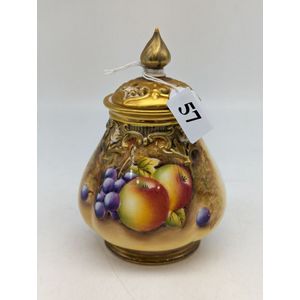
Royal Worcester Hand-Painted Fruit Potpourri Vase, Signed Lk Till
Royal Worcester potpourri, hand painted with fallen fruit decorations depicting apple and grapes and gilding decorations to lid, base and neck of the vase, signed Lk Till. Height 14 cm

Hand-painted Royal Worcester Potpourri Jar with Embossed Gilt Highlights
Royal Worcester potpourri jar, signed hand painted berries and leaves by M.Miller embossed gilt highlights, height 13.5 cm (small chip)

Royal Worcester Fruit Potpourri Urns, 1960
A pair of Royal Worcester lidded potpourri urns, Hadley shape, hand painted with fruit by N. Creed and one other, gilded embellishments to body and pierced lid, dates from 1960, height 11 cm.

Hand-painted Royal Worcester fruit potpourri urn
A Royal Worcester lidded potpourri urn, hand painted in the round with fruit by R. Price, gilded base and rim, pierced lid, dates from 1960, inner lid absent. 13 x 22 cm.

Blue Porcelain Potpourri with Swans and Swallows
Royal Worcester twin-handled porcelain potpourri, by Charles Baldwyn, c. 1903, shape 1515, moulded with Renaissance style ornament at the neck and base, the pale blue ground painted with a group of swans in flight and the reverse with swallows, printed…

Royal Worcester Porcelain Potpourri by John Stinton, c. 1907
Royal Worcester twin-handled porcelain potpourri, by John Stinton, c. 1907, shape 1515, moulded with Renaissance style ornament at the neck and base, the blush ivory ground painted with a group of cattle, printed factory marks to underside, artist's…

Royal Worcester Pot Pourri Pair
Pair of Royal Worcester pot pouri, late 19th and early 20th century, model 846, blush ivory reticulated bowls and covers with gilt accents, a moulded frieze to the lower body, raised on lion's paw feet, printed factory marks to undersides (2), height 14…

M. Hunt Signed Royal Worcester Potpourri - 16cm Height
A Royal Worcester potpourri, signed M. Hunt, height 16 cm

Signed Royal Worcester Fruit Pot Pourri (2)
Two Royal Worcester pot pourri, each painted with fruit, both signed by 'Lk Till', numbered H291 and H 278, printed mark from 1964 onwards, height: 13 and 14 cm. (2)

Antique Royal Worcester Porcelain Potpourri Vase, 19th/20th Century
Royal Worcester antique English porcelain potpourri vase, 19th/20th century, green factory mark to base, 19 cm high

19th Century Grainger & Co. Worcester Porcelain Potpourri
Grainger & Co. Worcester English porcelain potpourri, 19th century, factory mark to base, 8.5 cm high, 14 cm wide

Hand-painted Fruit Porcelain Vase by Freeman
Royal Worcester English porcelain potpourri vase with hand-painted fruit, signed 'Freeman', mid 20th century, black factory mark to base, 13.5 cm high

Hand-painted Fruit Porcelain Urn by Royal Worcester
Royal Worcester English porcelain potpourri urn, with hand-painted fruit decoration, signed 'H. Ayrton', early 20th century, puce factory mark to base, 18 cm high

Hand-painted Royal Worcester Potpourri Vase with Fruit Decoration
Royal Worcester English porcelain potpourri vase, with hand-painted fruit decoration, signed 'E. Townsend', early 20th century, puce factory mark to base, 21 cm high

Royal Worcester Potpourri Vase with Highland Cattle Decoration
Royal Worcester English porcelain pot pourri vase with highland cattle decoration, signed 'H. Stinton', black factory mark to base, 13 cm high

Royal Worcester Pot Pourri Jar, 1890
A Royal Worcester covered pot pourri jar, 1890, the small globular vase with a pierced neck and cap style cover, decorated with loose flower sprays enriched with fine gilding upon an ivory ground, puce backstamp and shape number 1039 underside, 13 cm high

Harry Ayrton Royal Worcester Pot Pourri Jar
A petite Royal Worcester covered pot pourri jar by Harry Ayrton, circa 1940, with gilded relief moulding to the body, a reticulated cover and featuring a fruit still life set in an intimate landscape setting, signed H Ayrton lower right, black backstamp…

William Hale Pot Pourri Jar, Royal Worcester
A Royal Worcester pot pourri jar by William Hale, 1912, ovoid with a reticulated dome cover and relief moulded borders to the collar and foot, decorated with polychrome wildflowers on a blush ivory ground, signed Hale to the decoration, puce backstamp and…

Ethel Spilsbury Royal Worcester Pot Pourri Jar
A Royal Worcester pot pourri jar by Ethel Spilsbury, 1926, of lobed form with an ornate gilded collar in relief and a pierced cover, decorated with Hadley style magenta and pink roses on a suffused ground, signed E. Spilsbsury below collar, puce backstamp…

Harry Davis Royal Worcester Pot Pourri Jar
A Royal Worcester covered pot pourri jar by Harry Davis, 1924, ovoid with basket weave moulding and a reticulated cover and internal lid, decorated to the body with Scottish black face sheep in an autumnal rural setting, signed H.Davis lower left, puce…

Harry Stinton Royal Worcester Pot Pourri Jar
A Royal Worcester pot pourri jar by Harry Stinton, circa 1930, ovoid with a moulded gilt collar and foot and surmounted by a reticulated turban cover, decorated with highland cattle in a suffused sunlit landscape, signed H. Stinton lower right, puce…

Harry Davis Royal Worcester Pot Pourri Jar
A Royal Worcester pot pourri jar by Harry Davis, 1922, ovoid with a gilded basketweave base and a moulded reticulated cover and an internal lid, decorated to the body with a scene of Scottish black face sheep in an autumnal rural setting, signed H. Davis…

Royal Worcester Rose Pot Pourri Jars by Ambrose Hood
A near pair of Royal Worcester pot pourri jars, one by Ambrose hood, 1910 and 1912, the 'Rose jars' with spiral flute reticulated lids and conforming decoration to the lower body in shot colours above a trellis moulded foot, both decorated with magenta…

Royal Worcester Highland Cattle Pot Pourri Vases by J. Stinton
A pair of Royal Worcester pot pourri vases by John Stinton, 1919, 1924, 1937/8, ovoid vases with reticulated rims, husk swags and moulded handles in gilt and shot colours, decorated with highland cattle in misty Scottish moorland settings, both signed J…

Hand-painted Highland Cattle Porcelain Pot Pourri
Royal Worcester porcelain pot pourri, decorated with hand painted highland cattle scene and gilding, signed by artist Harry Stinton, height 13 cm (lid missing)

Royal Worcester Rose Pot Pourri with Gilt Highlights
Royal Worcester Hadley ware lidded pot pouri pot with handpainted blooming roses, gilt highlights and pierced floral lid with finial, Circa 1909. height 11.5 cm

Royal Worcester Pot Pourri with Fruit Painting by Freeman
A Royal Worcester porcelain pot pourri, date letter for 1958, of squat lobate outline, the pierced cover with conical finial, with four scrolled feet, painted with apples and plums signed Freeman. Height 11 cm, other notes: John Freeman was born in 1911…

Three Ceramic Treasures: Worcester, Huntley, and Love
A Royal Worcester bud vase by M. Hunt, height 8 cm, an S.P. Huntley pot pourri, height 13.5 cm and a P.D. Love lidded urn, height 15.5 cm

Rare Royal Worcester Pot Pourri Vase with Lion Scene
Harry Davis (Royal Worcester) a very rare globular shaped lidded pot pourri vase painted with lions painted with an unusual African scene of lions stalking distant prey, a large male and a smaller female perched on craggy rocks watching a scattered herd…

Regal Crown Pot Pourri Vase with Windsor Castle Panel
Ernest Barker (Royal Worcester) a fine globular Regal Crown lidded pot pourri vase on vibrant cobalt blue ground with a hand painted panel of Windsor castle issued June 22 1911 for the Coronation of George V, shape no.2516, date mark 1911, height 18 cm,…

Large Crown Sheep Pot Pourri Vase by Harry Davis
Harry Davis (Royal Worcester) impressive large Crown lidded sheep painted pot pourri vase superbly allover painted with an idyllic scene of black face sheep overlooking a loch in the Scottish Highlands. Signed H. Davis shape no.2048, date mark 1919,…

Rare Royal Worcester Highland Cattle Pot Pourri Vases
John Stinton (Royal Worcester) a rare pair of two handle lidded highland cattle lidded pot pourri vases each with detailed hand painted scenes of highland cattle in mountainous landscapes, having finely gilded lids and handles signed J. Stinton shape no.…

Royal Worcester Pot Pourri with Swans & Gilding
Charles Baldwyn (Royal Worcester) an early lidded pot pourri, of pale blue and Darker blue ground featuring swans in flight over reeded Wetland, finely gilded with green highlights to handles and lid Initialled 'By' to base (early mark for Baldwyn) shape…

Seagulls on Stormy Sea Pot Pourri Vase
Ernest Barker (Royal Worcester) an attractive lidded pot pourri vase finely painted with seagulls in flight over a stormy sea, signed E. Barker with gilded triform base and pierced lid. Shape no. H 245 date mark 1929. Height 18 cm

Seagulls and Turbulent Sea Pot Pourri Vase
Charles Baldwyn (Royal Worcester) an exceptional lidded pot pourri vase finely painted with a unique subject continuous scene of seagulls flying over a Turbulent sea Against pale blue sky with two foliate scroll handles, pierced panels to neck, gilded…

Exotic Eastern Scene Pot Pourri Vase by A. Schuck (1913)
Albert Schuck (Royal Worcester) an impressive bulbous urn shaped pot pourri vase and cover painted with continuous exotic eastern scene of cranes at an oasis, finely gilded lid, foot and handles signed a. Schuck shape no. H 314, date mark 1913, height 28…

Large Baldwyn Potpourri with Seagull Scene
An exceptional large lidded pot pourri Charles Baldwyn (Royal Worcester) the body painted with rare scene of seagulls and terns in flight over the ocean. Two handles, lid and base of pale green with gilded highlights signed. C. H. Baldwyn. Shape no. 1515,…

Durham Cathedral Pot Pourri by Harry Davis (1910)
Harry Davis (Royal Worcester) a superbly painted lidded pot pourri painted with a scene of Durham Cathedral with river in the foreground. The reverse with a small painting of a bridge over the river. Inscribed under base Durham Cathedral signed H Davis.…

Antique Royal Worcester Porcelain Potpourri Vase, Floral Decoration
Royal Worcester antique English porcelain potpourri vase with hand-painted floral decoration, sage green mark to base, 14 cm high

Royal Worcester Fruit Pot Pourri Vase
Royal Worcester pot pourri vase and cover, compressed circular body painted with peaches, grapes, gooseberries and cherries signed T Lockyer #1286 circa 1933 20 cm high

Royal Worcester Fruit Pot Pourri Vase
A Royal Worcester pot pourri vase and cover, painted with fruit by Roberts, ovoid shape with moulded shoulder and foot highlighted with gilt, the pierced cover with cupola finial. Black mark, shape H169, height 20 cm
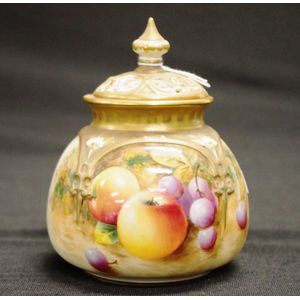
Hand-painted Royal Worcester Pot Pourri with Fruit Decoration
Royal Worcester signed hand painted pot pouri with fruit decoration and pierced gilt lid, signed William Roberts, marked to base and #H175, height 12 cm.

Hand-painted Royal Worcester Pot Pourri Jar with Fruit Decoration
Large Royal Worcester pot pourri jar and cover, with pierced cover set with pointed finial, set above an inner porcelain cover and large globular body, decorated with hand painted fruit, berries and foliage, signed Freeman, stamps to base, height 27 cm

Hand-painted Royal Worcester potpourri with pierced lid
Royal Worcester Fallen fruits pot pourri, hand painted and gilt fallen fruits with pierced decorated lid, signed N. Creed

John Stinton Royal Worcester Pot Pourri
A small Royal Worcester lidded pot pourri by John Stinton, 1924, the lobed vessel with a pierced gilded cover and pointed finial, moulded pendant shapes in shot colours to the collar and continuously decorated to the body with highland cattle scenes, puce…

Royal Worcester Pot Pourri by Charles Baldwyn, 1901
A lidded Royal Worcester pot pourri by Charles Baldwyn, 1901, the ovoid pot pourri featuring swans in flight against a sky blue ground, with moulded details to the domed cover and collar and high set scrolling handles, black backstamp underside, shape…

Harry Davis Royal Worcester Pot Pourri with Scottish Sheep
A Royal Worcester lidded pot pourri by Harry Davis, 1920, of bulbous profile featuring Scottish blackface sheep in a highland valley, with an ornate moulded and pierced neck and collar in white and gold colours and high set scrolling handles in shot…

Royal Worcester Fruit Pot Pourri Jar
Royal Worcester pot pourri jar and cover, with pierced cover above a lobed globular body, decorated with hand painted fruit, signed E. Townsend, stamps to base, height 14 cm

Royal Worcester Covered Vase with Fruit Decoration
A signed Royal Worcester covered vase, c1920, the covered vase or lidded potpourri jar of lobed tapering form upon a small foot with an applied decorative collar in shot enamels surmounted by a pierced domed lid with a pointed finial similarly embellished…

Rose Collection by M Hunt
Royal Worcester: a collection of miniature vases, a pot pourri and a cup and a saucer, all decorated with roses and seven signed 'M Hunt', the pot pourri with gilt pierced cover and on scroll feet, height of tallest vase 14.5 cm

Royal Worcester Porcelain Vase with Painted Roses, Signed
Royal Worcester potpourri porcelain vase with painted rose decoration, signed M. Lander, green factory mark to base, 16 cm high

Royal Worcester Potpourri Vases with Roses by Tansell
Pair Royal Worcester potpourri vases & covers, by John Tansell, hand-painted with roses, black printed factory mark and model no. 277/11 to base, height 14 cm. Provenance: Deceased Estate, Sydney.

Harry Stinton Highland Cattle Potpourri Vase
Royal Worcester potpourri vase & cover by Harry Stinton, Hand-painted with highland cattle in a landscape, black printed factory mark and model no.169/H to base, height 16.5 cm. Provenance: Deceased Estate, Sydney.

Royal Worcester Highland Cattle Pot Pourri by H. Stinton
A Royal Worcester 'Highland Cattle' pot pourri, painted by Harry Stinton, circa 1940S, of compressed ovoid form, the body painted with highland cattle scene to one side and mountainous landscape to the other, signed 'H Stinton'. Black factory mark to base…

Hand-painted Royal Worcester Potpourri (20cm)
A hand painted Royal Worcester potpourri, height 20 cm

Harry Stinton Highland Cattle Potpourri Vase
A Royal Worcester potpourri vase and cover, painted with Highland cattle by Harry Stinton, richly gilded to base, rim, lid and cover, signed, date mark 1952, shape 2048. Height 25 cm.
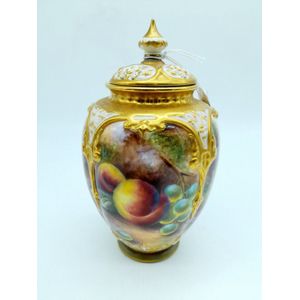
Hand-painted Royal Worcester pot pourri with gilt details
Royal Worchester Fallen fruits pot pourri, hand painted and gilt bulbous lidded pot pourri, signed P.D. Love

Hand-painted Royal Worcester Pot Pourri by K. Blaky
A hand painted Royal Worcester pot pourri, signed K. Blaky, height 11.5 cm

Royal Worcester Fruit Pot Pourri Jar
Royal Worcester pot pourri jar and cover, the body of baluster form, set with a pierced cover and spire finial, decorated with fruit and berries, signed Roberts, #H277, raised on a floriform four petal base, height 13.5 cm

Maybury's Royal Worcester Pot Pourri
Royal Worcester pot pourri, hand painted and gild with 'Fallen Fruit' pierced lidded pot pourri, signed Maybury, height 12 cm

Hand-painted Royal Worcester pot pourri with pierced lid
Royal Worcester pot pourri, hand painted with 'Fallen Fruit' and gilded decoration and pierced lid, signed Roberts, height 14 cm

Antique Royal Worcester Pot Pourri Jar, 1897
Royal Worcester blush ivory pot pouri jar dated 1897,with inner lid and pierced cover, decorated with hand painted floral decoration, height 19.5 cm, restoration to cover finial

Antique Royal Worcester Blush Ivory Pot Pourri Vase
Royal Worcester blush ivory pot pouri vase circa 1899, 14.5 cm high approx, no lid

Hand-painted Royal Worcester Pot Pourri by Sedgley
A Royal Worcester hand painted and gilt pot pourri, signed Sedgley, height 45 cm

Handpainted Royal Worcester Pot Pourri Jar with Rose Decoration
Royal Worcester handpainted pot pouri jar with inner lid and pierced cover, signed M. Hunt,decorated with handpainted rose decoration, height 13 cm

Royal Worcester Fruit Potpourri Jar
Royal Worcester signed potpourri jar lidded jar, hand signed, Roberts fruit decoration, gilt highlights, marked to base, and # 175, height 12.5 cm

Royal Worcester Hand-Painted Pot Pourri by Freeman
A large hand painted Royal Worcester pot pourri, signed Freeman, height 26 cm

Royal Worcester Potpourri Vases with Floral Designs
Two Royal Worcester lidded potpourri vases, one painted depicting a spray of poppies and wildflowers, and other with pink and yellow rose buds, both on ivory ground and heightened gilt. Date codes 1905, and 1900. Height 14 cm, 12.5 cm. Repaired to one and…

Royal Worcester Potpourri Vase and Cover, 1912
A Royal Worcester potpourri vase and cover, the pierced moulded cover, painted with sprays of flowers, on blush ivory ground. Date code 1912. Height 16 cm.

Royal Worcester Potpourri Vase with Roses by R. Austin
A Royal Worcester potpourri vase and cover, signed R. Austin, the pierced and moulded neck and cover, painted with pink and yellow roses. Green stamp mark H291. Height 16 cm.

Royal Worcester Hand-Painted Pot Pourri Vases
Two Royal Worcester pot pourri vases, the smaller of two handled squat circular form with pierced cover, the larger of lobed form (lacking lid) both hand painted with flowers on a blush ivory ground, of sizes

Handpainted Fruit Pot Pourri with Gilt Decoration
Royal Worcester signed Roberts pot pouri pot with handpainted fruit and gilt decoration, height 12 cm

Royal Worcester Highland Cattle Pot Pourri
Royal Worcester signed John Stinton pot pouri with hand painted highland cattle, reticulated lid on four feet, circa 1910, height 11 cm

Hand-painted Royal Worcester Potpourri with Gilt Lid
Royal Worcester fallen fruits potpourri with hand painted and with gilt pierced lid signed Roberts HN 261 marked to base

Hand-painted Royal Worcester potpourri with gilded pierced lid
Royal Worcester 'Fallen Fruits' potpourri with hand painted and gilt decoration with gilded pierced lid signed T. Lockyer. HN 278 marked to base
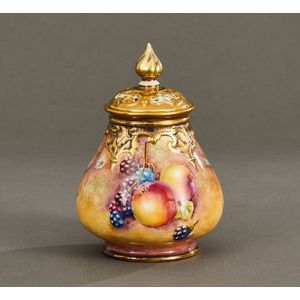
Fruit Landscape Potpourri Vase by L. K. Till
A Royal Worcester potpourri vase by L. K. Till, fully painted with fruit in a landscape, pierced lid, on squat round foot. Signed L. K. Till. Printed factory marks, shape H291. Height 12.3 cm

Royal Worcester Potpourri Vase by Harry Stinton, Highland Cattle
A Royal Worcester potpourri vase by Harry Stinton, painted with three highland cattle in a landscape with a highland scene to the reverse. Gilt highlights, base and pierced lid. Signed H. Stinton. Printed black factory marks, dated circa 1950, model 1286.…
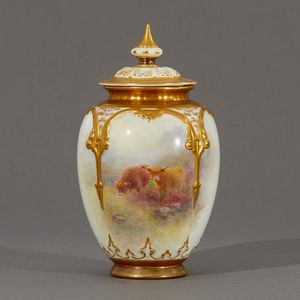
Harry Stinton Highland Cattle Pot Pourri Vase
A Royal Worcester lidded pot pourri vase and cover by Harry Stinton, painted with highland cattle in a landscape. Printed factory mark. Shape number 169/H. Date code 1956. Height 19.1 cm. Provenance: Sotheby's Belgravia, English ceramics, October 1976,…

Royal Worcester Rose Pot Pourri Vase with Gilt Cover
A Royal Worcester pot pourri vase and cover, painted with roses on white ground SP Huntley, the gilt cover being pierced and surmounted by finial. Shape H169, 19.5 cm high.
 Loading more...
Loading more...